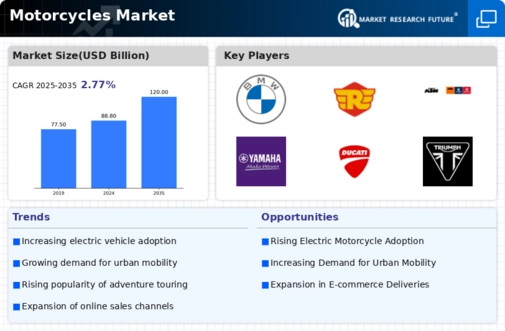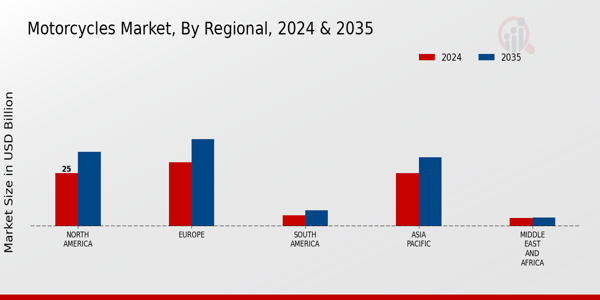Market Growth Projections
The Global Motorcycles Market Industry is poised for substantial growth, with projections indicating a market value of 120 USD Billion by 2035. This anticipated growth is underpinned by a compound annual growth rate of 2.77% from 2025 to 2035. Factors such as rising disposable incomes, urbanization, and a growing preference for two-wheelers are likely to drive this expansion. The market's evolution reflects changing consumer behaviors and preferences, suggesting a dynamic landscape that manufacturers must navigate to capitalize on emerging opportunities.
Technological Advancements
Technological innovations play a crucial role in shaping the Global Motorcycles Market Industry. Manufacturers are increasingly integrating advanced features such as anti-lock braking systems, smart connectivity, and improved fuel efficiency into their models. These enhancements not only elevate rider safety but also cater to the growing consumer demand for modern, high-performance motorcycles. As a result, the market is likely to witness a steady influx of new models equipped with cutting-edge technology. This trend aligns with the projected CAGR of 2.77% from 2025 to 2035, indicating a sustained interest in technologically advanced motorcycles.
Rising Demand for Two-Wheelers
The Global Motorcycles Market Industry experiences a notable increase in demand for two-wheelers, driven by urbanization and the need for efficient transportation solutions. As cities expand, the convenience of motorcycles for commuting becomes increasingly appealing. In 2024, the market is valued at 88.8 USD Billion, reflecting a growing preference for motorcycles over traditional vehicles. This trend is particularly pronounced in developing regions, where affordability and fuel efficiency are paramount. The shift towards two-wheelers is expected to continue, potentially contributing to the market's projected growth to 120 USD Billion by 2035.
Expansion of Distribution Channels
The Global Motorcycles Market Industry benefits from the expansion of distribution channels, which enhances accessibility for consumers. The rise of e-commerce platforms and online sales has transformed the way motorcycles are marketed and sold. Consumers can now easily compare models, prices, and features from the comfort of their homes. This shift not only broadens the market reach but also facilitates the entry of new brands and models. As the industry adapts to these changes, it is likely to see an increase in overall sales, contributing to the projected growth of the market in the coming years.
Environmental Concerns and Regulations
The Global Motorcycles Market Industry is significantly influenced by increasing environmental awareness and stringent regulations aimed at reducing emissions. Governments worldwide are implementing policies to promote cleaner transportation options, which includes the adoption of electric motorcycles. This shift is likely to reshape consumer preferences, as eco-friendly models gain traction. The market's evolution towards sustainable practices may also attract new entrants focused on electric and hybrid motorcycles. As the industry adapts to these changes, it could potentially enhance its overall market value, contributing to the anticipated growth trajectory.
Growing Interest in Recreational Riding
The Global Motorcycles Market Industry is witnessing a surge in interest in recreational riding, particularly among younger demographics. This trend is fueled by a desire for adventure and exploration, with many consumers seeking motorcycles for leisure rather than just transportation. Events such as motorcycle rallies and tourism-related activities are becoming increasingly popular, fostering a vibrant community of enthusiasts. This growing segment is likely to drive sales and encourage manufacturers to diversify their offerings, catering to various riding styles and preferences. As a result, the market may experience a positive impact on its overall growth.

























Leave a Comment